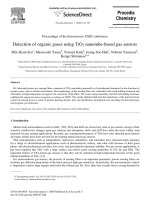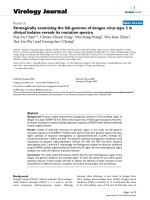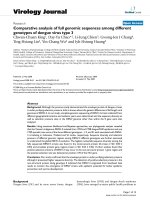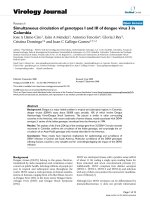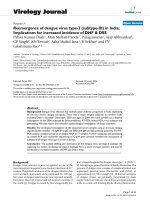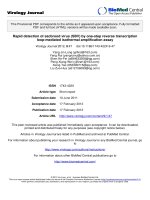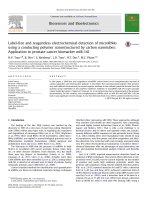Electrochemical detection of dengue virus using nanoporous membrane
Bạn đang xem bản rút gọn của tài liệu. Xem và tải ngay bản đầy đủ của tài liệu tại đây (2.32 MB, 148 trang )
ELECTROCHEMICAL DETECTION OF DENGUE
VIRUS USING NANOPOROUS MEMBRANE
PEH EN KAI ALISTER
(B.Sci.(Hons.), NUS)
A THESIS SUBMITTED FOR THE DEGREE OF
DOCTOR OF PHILOSOPHY OF SCIENCE
DEPARTMENT OF CHEMISTRY
NATIONAL UNIVERSITY OF SINGAPORE
2013
Acknowledgements
i
Acknowledgements
It would not have been possible to write this thesis without the help and
support of many kind people around me, to whom it is possible to give particular
mention here.
Above all, I would like to express my deepest gratitude to my supervisor
Professor Sam Li for his unwavering support throughout my Ph.D. course, his
patience, motivation, encouragement and immense knowledge. Thank you so
much for being there when I needed you.
My sincere thanks are extended to Professor Lee Hian Kee, Assistant
professor Toh Chee-Seng, Dr Nguyen Thanh Thi Binh and Ms Yin Thu Nyine
for their advice, help and guidance for the projects and for parting the
knowledge of electrochemical techniques and porous membranes.
My heartfelt appreciation to my collaborators for providing me with the
samples required by my projects; Professor Mary Ng and Ms Loy Boon Kheng
for providing the West Nile virus; Dr Katja Fink, Ms Ying Xiu and Mr Joseph
Ng for providing the Dengue virus; Professor Vincent Chow and Ms Kelly Lau
for providing the Dengue and Chikungunya virus.
I would like to acknowledge the financial, academic and technical
support of the Ministry of Education, National University of Singapore and its
staff. I also thank the Department of Chemistry for their support and assistance
Acknowledgements
ii
I am indebted to my honours year students: Judy Lee, Celine Chee and
Yeo Xue Xin, fellow graduate students, research assistants and research fellows
of the group for being understanding, for all the simulating discussion, support
and help.
Lastly, I would like to thank my family members, friends and relatives
for their unequivocal support, spiritually and emotionally.
Table of Contents
iii
Table of Contents
Acknowledgements i
Table of Contents iii
Summary vii
List of Tables ix
List of Figures xi
List of Abbreviations xv
List of Symbols xviii
Chapter 1: General introduction of Dengue virus and the current state of art
for Dengue detection 1
1.1. Dengue virus in general 1
1.2. Conventional methods for the detection of Dengue infection 4
1.3. Advanced methods fabricated for the detection of Dengue infection 12
1.4. Scope of research 19
1.5. References 21
Chapter 2: Electrochemical impedance spectroscopy characterisation of the
nanoporous alumina Dengue virus biosensor 28
2.1. Introduction 28
2.1.1. Fundamental of electrochemical impedance spectroscopy 28
2.1.2. Nanopores 32
2.2. Materials and methods 37
2.2.1. Materials and reagents 37
2.2.2. Virus cultivation and inactivation 37
2.2.3. Preparation of the nanobiosensor 38
2.2.4. Characterisation of the nanobiosensor 40
Table of Contents
iv
2.3. Results and discussion 42
2.3.1. Characterisation using cyclic voltammetry 42
2.3.2. Characterisation using electrochemical impedance spectroscopy 43
2.3.3. Dengue virus-antibody binding affinity 51
2.3.4. Selectivity experiment 52
2.3.5. Real sample analysis 55
2.4. Conclusion 56
2.5. References 57
Chapter 3: Dengue virus detection using impedance measured across the
nanoporous alumina membrane 62
3.1. Introduction 62
3.1.1. Replication of Dengue virus 62
3.1.2. The immature Dengue virus particles 63
3.1.3. Porous anodic aluminium oxide (AAO) 65
3.2. Materials and methods 68
3.2.1. Materials and reagents 68
3.2.2. Fabrication of the Pt film working and counter electrode on the alumina
membrane 68
3.2.3. Cell assembly and electrochemical measurement 69
3.2.4. Preparation of the immunosensor 69
3.3. Results and discussion 71
3.3.1. Immunosensor fabrication 71
3.3.2. Impedance sensing for the detection of Dengue virus 72
Table of Contents
v
3.3.3. Binding affinity studies of the 2H2 antibody with Dengue 2 and Dengue
3 viruses 76
3.3.4. Effect of the membrane's nominal size on sensing capacity 79
3.3.5. The specificity of the immunosensor 81
3.3.6. Real sample analysis 82
3.4. Conclusion 83
3.5. References 84
Chapter 4: A nanofluidics membrane-based detection and serotyping of
Dengue virus 88
4.1. Introduction 88
4.1.1. Current state-of-art in disease diagnosis 88
4.1.2. Nanofluidics 90
4.1.3. Adsorption of protein on surfaces 91
4.1.4. Use of ferrocene as an electroactive label 92
4.2. Theory 94
4.2.1. Discussion of the sensing mechanism at the working electrode 94
4.2.2. Mass transport of ferrocene labelled protein probes across the
membrane 96
4.3. Materials and methods 99
4.3.1. Materials and reagents 99
4.3.2. Grafting of Dengue virus particles or anti-Dengue virus antibodies onto
the nanochannels of the membrane 100
4.3.3. Preparation of IgG/BSA labelled with Fc-COOH 100
4.3.4. Analysis procedure of the membrane biosensor system 101
4.3.5. Real sample analysis 102
Table of Contents
vi
4.4. Results and discussion 105
4.4.1. Characterisation of the membrane biosensor setup 105
4.4.2. Selectivity and specificity of the virus grafted biosensor 107
4.4.3. Selectivity and specificity of the antibody grafted biosensor 111
4.4.4. Real sample analysis 116
4.5. Conclusion 119
4.6. References 120
Chapter 5: Overall conclusion and future perspective 124
List of Publications 127
Summary
vii
Summary
This thesis entails the development of membrane-based biosensors for
the detection and serotyping of an infecting Dengue virus. The projects aim to
explore sensing platforms which can possibly be miniaturised into a point-of-
care diagnostic tool. Early disease diagnosis is particularly important since the
fluid treatment and monitoring is currently the only way to fight against the
disease. Anodic aluminum oxide (alumina) membrane is chosen because of its
good mechanical stability and regularity in pore sizes. These nano-sized pores
permit high throughput analysis, better sensitivity and selectivity due to their
large surface-area-to-volume ratio and close intimation with biomolecules of
similar sizes. Electrochemical techniques are employed as the detecting
platform because they can be easily miniaturised and the data can be output into
values easily understood by an end-user.
In chapter 1 we used a home-made alumina membrane to detect the
presence of the Dengue virus. The membrane electrode was fabricated by
anodising and etching the coated aluminum metal. Impedance studies of the
system reveal that the electrode surface is insensitive to the Dengue virus. This
phenomenon is different from the conventional electrodes reported. In addition,
the channel's capacitance can be used to differentiate the Dengue virus from
other flaviviruses. The antigen-antibody binding was found to follow the
Freundlich isotherm which is commonly used to describe the binding within
porous systems. The main disadvantage of the biosensor is the alumina layer
dislodging during washing steps.
Summary
viii
In chapter 2, we fabricated another alumina electrode sensor by coating
a layer of conductive platinum metal onto a commercially available alumina
membrane with a diameter of 13 mm and a thickness of 60 μm. This biosensor
is mechanically more stable than the home-made one since neither the alumina
membrane nor the platinum layer dislodges during the preparation and analysis
process. In addition, the biosensor design is very neat as the membrane acts as
the working and counter electrode. This biosensor can achieve a lower detection
limit than the home-made biosensor with similar preparation conditions.
In the last chapter, we demonstrated a proof of concept that using a flow-
based system, unknown Dengue viruses can potentially be differentiated and
serotyped. The process involves manipulating the properties of nanofluidics
where the redox probes are made to diffuse across the alumina membrane
immobilised with unknown Dengue viruses. The analysis time is similar to the
RT-PCR process but is generally less complicated and unlikely to suffer from
contaminations. Besides, with simple assumptions that the diffusion of the
redox probes follows the Fick's first law and these probes will foul the electrode
surface, we can adequately simulate and fit the observed data.
List of Tables
ix
List of Tables
Chapter 2
Table 2.1. The impedance, phase shift and the frequency dependence of the
impedance elements most often used to describe an electrochemical system 30
Table 2.2. Fitted EIS results of the nanobiosensor using the equivalent circuit
shown in fig. 2.6 and an average bulk solution resistance R
s
=1.9 KΩ 50
Table 2.3. Fitted EIS results of the nanobiosensor placed in the following
solutions: pure culture medium, CHIKV, WNV and DENV 2, respectively in
consecutive steps, using the equivalent circuit presented 54
Chapter 3
Table 3.1. Fitted values of the Nyquist plots showing pore resistance (R
p
) and
membrane capacitance (C
m
) 77
Table 3.2. Summarised table showing the techniques used to detect Dengue
infection, their required analysis time and limits of detection 77
Chapter 4
Table 4.1. Values of the (nFmA
0
B) and (k
a
N) parameters in equation 5 obtained
from non-linear curve fitting 104
Table 4.2. Values of the diffusion coefficient, (x) and ratio (y) parameters in
equation 9 obtained from the simulation of the labelled BSA transvering
through the bare membrane 107
Table 4.3. Values of the diffusion coefficient, (x) and ratio (y) parameters in
equation 9 obtained from the simulation of the labelled antibodies transvering
through the control and the respective virus grafted membrane 111
List of Tables
x
Table 4.4. Values of the diffusion coefficient, (x) and ratio (y) parameters in
equation 9 obtained from the simulation of the labelled antibodies transvering
through the control and antibody grafted membrane, incubated with the
respective Dengue virus 114
Table 4.5. Values of the diffusion coefficient, (x) and ratio (y) parameters in
equation 9 obtained from the simulation of the labelled antibodies transvering
through the antibody grafted membrane, incubated with the respective real
samples 118
List of Figures
xi
List of Figures
Chapter 1
Fig. 1.1. Development of the disease adopted from ref (1) 3
Fig. 1.2. Comparison of diagnostic tests according to their accessibility and
confidence adopted from ref (1) 12
Fig. 1.3. Overview of the nanoscale sensitive instrument-based biosensors and
nanoscale material-based biosensors used for the detection of Dengue
infection 13
Fig. 1.4. Schematic diagram showing conductance measurement using a
nanowire-based field-effect transistor sensor 17
Fig. 1.5. Schematic diagram illustrating the recognition and detection of
Dengue RNA using a liposome-based biosensor 18
Chapter 2
Fig. 2.1. (A) Schematic diagram of a conical nanopore which mimics functions
of biological nanopores formed by the track-etch method in a polyethylene
terephthalate (PET) membrane; (B) Schematic diagram of the experimental
setup used for the electrochemical measurement of ion currents traversing
across a single conical nanopore within a PET membrane 35
Fig. 2.2. (A) Schematic diagram illustrating the formation of one nanopore after
anodisation with oxalic acid solution and etching with 3% phosphoric acid; (B)
Schematic diagram showing the immobilisation of the antibody, BSA and
Dengue virus along the wall of the nanoporous membrane 40
List of Figures
xii
Fig. 2.3. Schematic diagram showing the three electrode system used in the
electrochemical detection 41
Fig. 2.4. Cyclic voltammetries of the alumina electrode after each step of the
nanobiosensor preparation procedure: before and after chemical etching,
antibody immobilisation, BSA immobilisation and virus capture in PBS
containing 1 mM ferrocenemethanol ………… 43
Fig. 2.5. (A) Real (in-phase) impedance Z′ and (B) imaginary (out-of-phase)
impedance Z″ versus angular frequency, ω, (C) Nyquist plot and (D) Bode-
phase plot of the nanobiosensor after Dengue 2 virus capture from solutions of
increasing virus concentration. Measurements were conducted in PBS (pH=7.4)
containing 1 mM ferrocenemethanol 46
Fig. 2.6. Schematic diagram of the alumina nanobiosensor for Dengue 2 virus
detection mapped with the equivalent circuit model showing the 3 distinct
regions 47
Fig. 2.7. Calibration plot of the change in channel resistance against the
concentration of Dengue 2 virus (PFU mL
-1
) 49
Fig. 2.8. Diagram showing the goodness-of-fit for the three isotherms:
Langmuir, Langmuir-Freundlich and Freundlich isotherm against the actual
data ………………………………………………………………………… 52
Fig. 2.9. Plot of the signal response against the concentration of Dengue 2 virus
in the spike serum samples 55
Chapter 3
Fig. 3.1. The general life cycle of a flavivirus adopted from ref (1) 64
Fig. 3.2. (A) An electrochemical cell setup with the platinum coated alumina
membrane acting as the working (WE) and counter electrode (CE) together with
an external Ag/AgCl reference electrode (RE) 70
Fig. 3.3. Scanning electron micrographs of (A) Uncoated 200 nm alumina
membrane (B) Pt coated 200 nm alumina membrane 72
List of Figures
xiii
Fig. 3.4. Nyquist plots of the alumina membrane electrode after antibody
immobilisation, BSA immobilisation and virus capture in PBS (pH=7.4)
containing 10 mM Fe(CN)
6
3-/4-
, bias potential of 0.25 V, frequency range of 0.1
Hz to 1 MHz; (A) Dengue 2 virus (B) Dengue 3 virus; (a) 1 PFU mL
-1
(b) 11
PFU mL
-1
(c) 61 PFU mL
-1
(d) 161 PFU mL
-1
(e) 361 PFU mL
-1
(f) 861 PFU
mL
-1
of Dengue viruses 73
Fig. 3.5. The equivalent circuit for the Nyquist plot 74
Fig. 3.6. Calibration plot of the change in pore resistance against the
concentration of (A) Dengue 2 virus and (B) Dengue 3 virus 76
Fig. 3.7. Bar charts illustrating the difference in the interactions between the
2H2 antibody with the Dengue 2 and Dengue 3 virus at pH 7.4 (A and B) and
pH 6.4 (C and D). Experiments were done in consecutive steps from left to
right 80
Fig. 3.8. Scanning electron micrographs of (A) Uncoated 20 nm alumina
membrane (B) Pt coated 20 nm alumina membrane 80
Fig. 3.9. Bar charts illustrating the response of the alumina membrane to the
Dengue 2 virus at two different pore sizes: 20 nm and 200 nm. Experiments
were done in consecutive steps from left to right 81
Fig. 3.10. Bar charts illustrating the selectivity of the 2H2 antibody towards the
Dengue serotype 2 virus and Chikungunya virus. Experiments were carried out
in a consecutive manner from left to right 82
Fig. 3.11. Plot of signal response against the concentration of Dengue 2 virus in
the spike serum samples 83
Chapter 4
Fig. 4.1. Schematic diagram of the experimental setup (feed compartment: 100
µL of IgG-Fc, receiver compartment: 500 µL of PBS pH 7.4, WE: Glassy
carbon electrode, RE: Ag/AgCl (1 M KCl), CE: (Pt wire mesh) 103
List of Figures
xiv
Fig. 4.2. Amperometric response of the glassy carbon electrode towards
ferrocene tagged BSA proteins under stirred condition. The solid lines represent
the curve fitted data using equation 5 to derive (nFmA
0
B) and (k
a
N) shown in
Table 4.1 103
Fig. 4.3. (A) Increase in BSA concentration (determined using BCA kit assay)
in the receiver solution after transversing an unmodified membrane from the
feed solution; (B) Signal response of the electrochemical detector towards
ferrocene labelled BSA as it transverse the unmodified membrane from 3
different concentrations of feed solution. Fitted lines represent the simulated
data 106
Fig. 4.4. Schematic diagram illustrating the virus grafted nanochannels; (A)
Control nanochannel (B) Dengue 3 virus grafted nanochannel (C) Dengue 2
virus grafted nanochannel, followed by the addition of ferrocene labelled 3H5
anti-Dengue 2 virus antibodies on the feed side of a 2-compartment cell. Eluted
redox labelled antibodies are detected at the receiver side by electrochemical
detection 108
Fig. 4.5. (A) Electrode response towards ferrocene labelled anti-Dengue 2 virus
antibodies as they transverse through the Dengue grafted membrane; (B)
Repeated experiments after regeneration of the same membrane. Fitted lines
represent the simulated data 109
Fig. 4.6. Schematic diagram illustrating the antibody grafted nanochannels,
followed by incubation in a sample containing unlabelled viruses; (A) Control
nanochannel (B) Nanochannel immobilised with Dengue 3 viruses (C)
Nanochannel immobilised with Dengue 2 viruses, followed by elution
experiment of ferrocene labelled anti-Dengue 2 virus antibodies as in (Fig.
4.4) 112
Fig. 4.7. Electrode response towards ferrocene labelled anti-Dengue 2 virus
antibodies as they transverse through the antibody grafted membrane after 1
hour incubation with the Dengue 2 and 3 viruses, respectively. Regeneration of
the membrane was done in consecutive steps (top-down) after each analysis.
Fitted lines represent the simulated data 113
Fig. 4.8. Electrode response towards ferrocene labelled anti-Dengue 2 virus
antibodies as they transverse through the antibody grafted membrane after 1
hour incubation with the uninfected human serum sample and human serum
samples infected with Dengue 2, 3 and 4 viruses. Regeneration of the membrane
was done in consecutive steps (top-down) after each analysis. Fitted lines
represent the simulated data 117
List of Abbreviations
xv
List of Abbreviations
AAO Anodic aluminum oxide
APS 3-aminopropyltrimethoxysilane
BCA bicinchoninic acid
BSA Bovine serum albumin
C Capsid protein
C Capacitance
C Concentration
CE Counter electrode
CHIKV Chikungunya virus
CPE Constant phase element
DENV 1 Dengue serotype 1 virus
DENV 2 Dengue serotype 2 virus
DENV 3 Dengue serotype 3 virus
DENV 4 Dengue serotype 4 virus
DHF Dengue Hemorrhagic Fever
DMSO Dimethyl sulfoxide
DNA Deoxyribonucleic acid
DPV Differential pulse voltammetry
DSS Dengue Shock Syndrome
E Envelope protein
ED III Envelope domain 3 protein
List of Abbreviations
xvi
EDC 1-ethyl-3-
[3 dimethylaminopropyl]carbodiimidehydrochloride]
EIS Electrochemical impedance spectroscopy
ELISA Enzyme-linked immunosorbent assay
ER Endoplasmic reticulum
FBS Fetal bovine serum
Fc Ferrocene
FESEM Field emission scanning electron microscopy
GC Glassy carbon electrode
HI Hemagglutination inhibition
ICP-MS Inductively coupled plasma mass spectrometry
IgG Immunoglobulin G
IgM Immunoglobulin M
LC-MS Liquid chromatography mass spectrometry
M Membrane protein
MAC-ELISA IgM antibody capture enzyme-linked immunosorbent
assay
MOI Multiplicity of infection
NC Nucleocapsid
NHS N-Hydroxysuccinimide
NS 1 Non-structural protein 1
NS 2a Non-structural protein 2a
NS 2b Non-structural protein 2b
NS 3 Non-structural protein 3
NS 4a Non-structural protein 4a
List of Abbreviations
xvii
NS 4b Non-structural protein 4b
NS 5 Non-structural protein 5
PBS Phosphate buffered saline
PC Photonic crystals
PCR Polymerase chain reaction
PET Polyethylene terephthalate
PrM Precursor form of membrane protein
PRNT Plaque reduction neutralisation test
QCM Quartz crystal microbalance
R Resistance
RE Reference electrode
RNA Ribonucleic acid
RT-PCR Reverse transcriptase polymerase chain reaction
SPR Surface plasmon resonance
TGN Trans-golgi network
W Warburg diffusion
WE Working electrode
WNV West Nile virus
List of Symbols
xviii
List of Symbols
K
ct
Heterogeneous rate coefficient
R Gas constant
T Temperature
F Faraday constant
A Area
A
t
Area at time (t)
A
0
Initial area of the surface
C
bulk
Concentration of the bulk solution
C
feed
Concentration of the feed solution
C
channel,feed
Concentration of the channel near the feed side
ρ
c
Channel resistivity
K Binding constant between the antibody and antigen
K
a
Rate of adsorption
D Diffusion coefficient
θ Fraction coverage
R
1
Channel resistance
R
2
Charge transfer resistance
R
s
Solution resistance
R
p
Pore resistance
ΔR
p
Change in pore resistance
R
et
Electron transfer resistance
C
m
Membrane capacitance
CPE
1
Membrane-electrolyte capacitance
List of Symbols
xix
CPE
2
Electrode-electrolyte capacitance
t Time
i Current
i
t
Current at time t
i
0
Initial current
J Flux
N Total number of available binding sites
l
m
Length of the nanochannel/Thickness of the membrane
E
t
Potential at time (t)
E
0
Initial potential
ω Radial frequency
Z
o
Magnitude of impedance
Z* Overall impedance
Z' Real impedance
Z'' Imaginary impedance
ϕ Phase shift
n
1
,n
2
Fractal order of reaction
m Mass transfer coefficient
Chapter 1
1
Chapter 1: General introduction of Dengue virus and the current state of
art for Dengue detection
1.1. Dengue virus in general
Dengue is the most rapidly spreading, acute febrile mosquito-borne viral
disease caused by the Dengue virus. Over the past 50 years, the incidence of
Dengue had increased by approximately thirty folds, spreading across
increasing number of countries as well as from the rural to urban regions. This
disease is now endemic in most tropical and subtropical regions. An estimated
number of about 50 million cases of Dengue fever occur per year with 500,000
cases of Dengue Hemorrhagic Fever and 22,000 deaths. Presently, about 2.5
billion people live in over 100 Dengue endemic countries (1). The presence of
Dengue has inflicted significant health, social and economic burden on these
endemic areas (2). Hence decreasing the number of outbreaks and if possible
eliminating the disease will be of utmost importance. There are several factors
that contribute to the occurrence of the disease, mainly the increases in
international travel and human population, besides global climate change (3).
The Dengue virus belongs to the flavivirus genus of the flaviviridae
family. The Dengue virus is transmitted to vertebrates by infected Aedes
aegypti and Aedes albopictus mosquitoes when they feed on their blood. The
Dengue virus is divided into four antigenically related but distinct serotypes;
Dengue 1 (DENV-1), Dengue 2 (DENV-2), Dengue 3 (DENV-3) and Dengue
4 (DENV-4). The mature Dengue virus is spherical in shape and approximately
Chapter 1
2
50-60 nm in size. It contains a single-stranded RNA of 11,000 nucleotide bases
in length. This RNA resides within a nucleocapsid which is enclosed by a lipid
bilayer containing three structural proteins (4-6). The RNA genome is
organised into 2 basic and distinct regions. The first region codes for 3 structural
proteins; capsid protein (C), precursor of the membrane protein (prM) and
envelope protein (E). The next region codes for three large non-structural
proteins: NS1, NS3 and NS5 and four smaller non-structural proteins: NS2a,
NS2b, NS4a and NS4b. Overall, the sequence of RNA genome is as follows:
5’-C-prM-E-NS1-NS2a-NS2b-NS3-NS4a-NS4b-NS5-3’ in terms of protein
expression.
There are three major complexes within the flaviviridae family: the
Tick-borne encephalitis virus, Japanese encephalitis virus and Dengue virus. All
flaviviruses share similar morphology and a genomic structure, with a common
antigenic determinant. As a consequence, the specific identification of a family
member poses significant challenge for serological methods owing to extensive
cross-reactivity of the antibodies in the serum. The situation is worst in Dengue
virus since it comprises four serotypes. Despite this extensive cross-reactivity,
infection by one of the Dengue serotype usually confers lifelong immunity
against the homologous serotype but not the other three serotypes (4).
Dengue infection can be caused by any of the four serotypes with
varying severity. Infection in human leads to a wide spectrum of illnesses,
ranging from mild febrile illnesses to fatal hemorrhagic diseases. Dengue fever
is usually characterised by a sudden onset of fever which normally last 2-7 days,
together with a variety of nonspecific signs and symptoms such as high fever,
Chapter 1
3
headache, nausea, vomiting, joint pain, fatigue and rashes. The entire course of
the illness can be broadly divided into three phases; febrile, critical and recovery
phase (1). During the critical phase, some individuals may progress to a severe
plasma leakage in cases with Dengue Hemorrhagic Fever (DHF) or Dengue
Shock Syndrome (DSS), severe haemorrhage and severe organ involvement (1,
7). The warning signs for severe Dengue include persistent vomiting, mucosal
bleeding, lethargy, abdominal pain or tenderness, clinical fluid accumulation,
restlessness, liver enlargement of more than 2 cm and an increase in the
hematocrit count with a rapid decrease in platelet count (1). Shock ensues when
a critical volume of the plasma is lost through leakage. A prolonged shock may
lead to coagulopathy and multiorgan failure. Careful monitoring of the blood
counts, the assessment of hemodynamic status and recognition of these warning
signs allow early treatment intervention. Appropriate fluid management and
supportive care are vital to the recovery (Fig. 1.1).
Fig. 1.1 Development of the disease adopted from ref (1).
Chapter 1
4
Currently, there are no effective vaccines or drugs to prevent or treat
Dengue infection. Hence, the most effective way to reduce the spread of the
disease is to control vector multiplication (5, 8). However, the global attention
to this issue is required since migration and geographical expansion can lead to
the transportation of the virus from one place to another (6). Until a global
cooperation of the vector control can be achieved or an effective vaccine
becomes available, early diagnosis remains an important tool for case
confirmation and clinical care. Relying solely on clinical diagnosis can be
problematic since the symptoms of Dengue infection are nonspecific, in
particular during the early febrile phase (5). Laboratory diagnosis methods
relying on genome and antigen detection as well as serological methods have
been widely applied. Conventional serological methods include
hemagglutination inhibition (HI), plaque reduction neutralisation test (PRNT)
and enzyme-linked immunosorbent assay (ELISA) whereas antigen detection
methods are virus isolation and reverse transcriptase polymerase chain reaction
(RT-PCR).
1.2. Conventional methods for the detection of Dengue infection
Hemagglutination inhibition (HI) is a modification of the
hemagglutination test. Instead of measuring the amount of agglutination when
the antigens are mixed with the red blood cells, the method measures the amount
of anti-Dengue antibodies in the sera required to displace the agglutination.
Details of the method had been neatly summarised by Clarke and Casals (9).
Optimally, the HI test requires paired sera obtained in the acute- and
